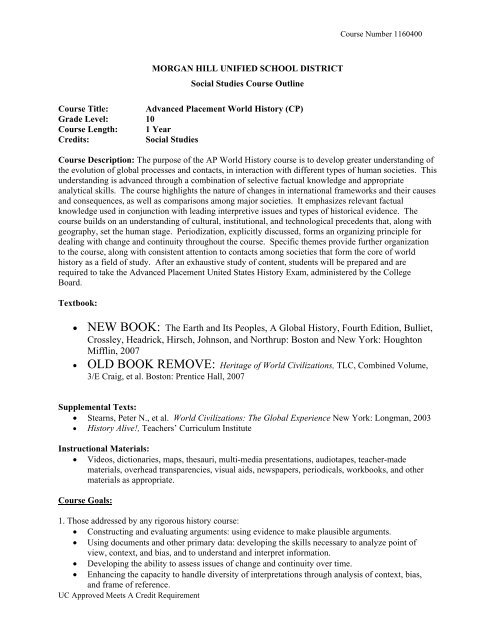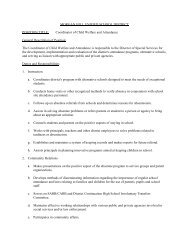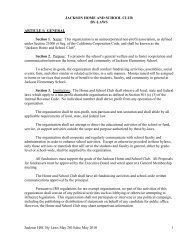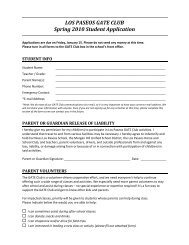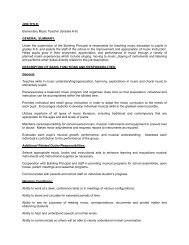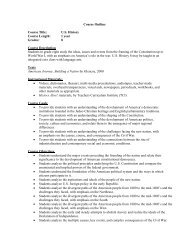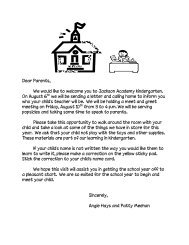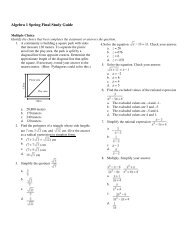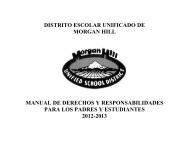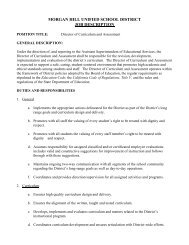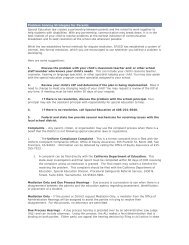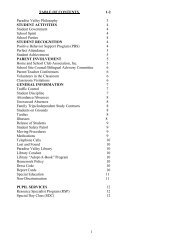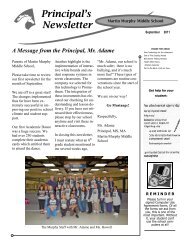NEW BOOK - Morgan Hill Unified School District
NEW BOOK - Morgan Hill Unified School District
NEW BOOK - Morgan Hill Unified School District
You also want an ePaper? Increase the reach of your titles
YUMPU automatically turns print PDFs into web optimized ePapers that Google loves.
Course Number 1160400MORGAN HILL UNIFIED SCHOOL DISTRICTSocial Studies Course OutlineCourse Title: Advanced Placement World History (CP)Grade Level: 10Course Length: 1 YearCredits:Social StudiesCourse Description: The purpose of the AP World History course is to develop greater understanding ofthe evolution of global processes and contacts, in interaction with different types of human societies. Thisunderstanding is advanced through a combination of selective factual knowledge and appropriateanalytical skills. The course highlights the nature of changes in international frameworks and their causesand consequences, as well as comparisons among major societies. It emphasizes relevant factualknowledge used in conjunction with leading interpretive issues and types of historical evidence. Thecourse builds on an understanding of cultural, institutional, and technological precedents that, along withgeography, set the human stage. Periodization, explicitly discussed, forms an organizing principle fordealing with change and continuity throughout the course. Specific themes provide further organizationto the course, along with consistent attention to contacts among societies that form the core of worldhistory as a field of study. After an exhaustive study of content, students will be prepared and arerequired to take the Advanced Placement United States History Exam, administered by the CollegeBoard.Textbook:• <strong>NEW</strong> <strong>BOOK</strong>: The Earth and Its Peoples, A Global History, Fourth Edition, Bulliet,Crossley, Headrick, Hirsch, Johnson, and Northrup: Boston and New York: HoughtonMifflin, 2007• OLD <strong>BOOK</strong> REMOVE: Heritage of World Civilizations, TLC, Combined Volume,3/E Craig, et al. Boston: Prentice Hall, 2007Supplemental Texts:• Stearns, Peter N., et al. World Civilizations: The Global Experience New York: Longman, 2003• History Alive!, Teachers’ Curriculum InstituteInstructional Materials:• Videos, dictionaries, maps, thesauri, multi-media presentations, audiotapes, teacher-madematerials, overhead transparencies, visual aids, newspapers, periodicals, workbooks, and othermaterials as appropriate.Course Goals:1. Those addressed by any rigorous history course:• Constructing and evaluating arguments: using evidence to make plausible arguments.• Using documents and other primary data: developing the skills necessary to analyze point ofview, context, and bias, and to understand and interpret information.• Developing the ability to assess issues of change and continuity over time.• Enhancing the capacity to handle diversity of interpretations through analysis of context, bias,and frame of reference.UC Approved Meets A Credit Requirement
• To communicate historical understandings through written expression in essay format.
2. Those addressed by a world history course:• Seeing global patterns over time and space while also acquiring the ability to connect localdevelopments to global ones and to move through levels of generalizations from the global to theparticular.• Developing the ability to compare within and among societies, including comparing societies’reaction to global processes.• Developing the ability to assess claims of universal standards yet remaining aware of humancommonalities and differences; putting culturally diverse ideas and values in historical context,not suspending judgment but developing understanding.Major Objectives of the Course:Thematic ObjectivesStudents will understand:• Patterns and impacts of interaction among major societies: trade, war, diplomacy, andinternational organizations.• The relationship of change and continuity across the world history periods covered in this course.• Impact of technology and demography on people and the environment (population growth anddecline, disease, manufacturing, migrations, agriculture, weaponry).• Systems of social structure and gender structure (comparing major features within and amongsocieties and assessing change).• Cultural and intellectual developments and interactions among and within societies.• Changes in functions and structures of states and in attitudes toward states and political identities(political culture), including the emergence of the nation-state (types of political organization).Foundations and the Classical Era: circa 8000 B.C.E. – 600 C.E.• Major Developments• Locating world history in the environment and time• Developing agriculture and technology• Basic features of early civilizations in different environments: culture, state, and social structure.In addition, you should know enough about two early civilizations to compare them.• Classical civilizations• Basic features and locations of major world belief systems prior to 600 C.E.• Late Classical period 200 C.E. to 600 C.E.The Postclassical Era: 600 C.E. – 1450• Major Developments• Questions of periodization• The Islamic world• Interregional networks and contacts• China’s internal and external expansion• Developments in Europe• Social, cultural, economic, and political patterns in the Amerindian world• Demographic and environmental changesGlobal Connections: 1450 – 1750• Major Developments• Questions of periodization• Changes in trade, technology, and global interactions; e.g. the Columbian Exchange, the impactof guns, changes in shipbuilding, and navigational devices• Knowledge of major empires and other political units and social systems (Mixed Sources)• Slave systems and slave trade
• Demographic and environmental changes: diseases, animals, new crops, and comparativepopulation trends• Cultural and intellectual developmentsIndustry and Revolution: 1750 -1914• Major Developments• Questions of periodization• Changes in global commerce, communications, and technology• Demographic and environmental changes (migrations; end of the Atlantic slave trade; newbirthrate patterns; food supply)• Changes in social and gender structure (Industrial Revolution; commercial and demographicdevelopments; emancipation of serfs/slaves; tension between work patterns and ideas aboutgender• Political revolutions and independence movements; new political ideas• Rise of Western dominance (economic, political, social, cultural and artistic; patterns ofexpansion; imperialism and colonialism) and different cultural and political reactions (reform,resistance, rebellion, racism, nationalism)• Patterns of cultural and artistic interactions among societies in different parts of the world(African and Asian influences on European art; cultural policies of Mejii Japan)The 20 th Century: 1914 - Present• Major Developments• Questions of Periodization• The World Wars, the Holocaust, the Cold War, nuclear weaponry, international organizations,and their impact on the global framework (globalization of diplomacy and conflict; globalbalance of power; reduction of European influence; the League of Nations; United Nations; Non-Aligned Nations, etc.)• New patterns of nationalism (fascism; decolonization; racism, genocide; the breakup of the SovietUnion)• Impact of major global economic developments (the Great Depression; technology; Pacific Rim;multinational corporations)• New forces of revolution and other sources of political innovations• Social reform and social revolution (changing gender roles; family structures; rise of feminism;peasant protest; international Marxism; religious fundamentalism)• Globalization of science, technology, and culture• Demographic and environmental changes (migrations; changes in birthrates and death rates; newforms of urbanization; deforestation; green/environmental movements)Outline of Course (Major Units):1. Foundations: circa 8000 B.C.E. – 600 C.E.2. The Postclassical Era: 600 C.E. – 14503. Global Connections: 1450 – 17504. Industry and Revolution: 1750 – 19145. The 20 th Century: 1914 – Present
Methods of Instruction• Lecture• Discussion• Group/Individual Activities• Reading Assignments• Document Based Question and Free Response Question Essays• Audio Visual Materials and Computer Technology• Other Methods as Deemed AppropriateAssessment methods and/or toolsAssessments will be based on the measurement of the degree to which objectives have been met beyondthe College Preparatory United States History course objectives.• Objective exams and quizzes• Participation in classroom discussion• DBQ and Free Response Essays• Maps, charts and graphs• Oral or written reports• Final examination• College Board AP World History Exam


